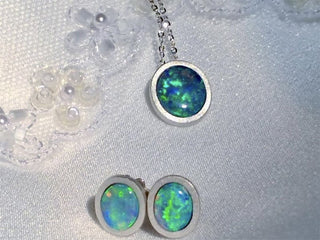More and more often, jewelry made of so-called 'synthetic opal' is found for sale in jewelry stores, online, or in shop windows. This material is made with resins that imitate precious opal, sometimes sold without specifying that it is fake opal, often misleading inexperienced buyers.
How to recognize a fake opal from a real opal?
The first and most obvious difference between genuine and fake opal is price. Natural opal, mined and processed from the rough, is obviously significantly more expensive than one processed with resins in a laboratory, due both to the difficulty of finding it and the rarity of the high-quality mineral. Synthetic products that imitate black opal and Australian white opal are commercially available and marketed as low-quality costume jewelry, whose only appeal is their affordable price.
A second immediately noticeable characteristic of imitation opal is the repetition of similar colors and patterns in each piece. A closer look reveals some typical features, such as the " snakeskin" effect and the stacked tubular texture.
A natural opal has a remarkable peculiarity; each gem is unique in both color and pattern, and the presence of imperfections, such as grains of sand, intrusions, and fractures, are indicative of the gem's naturalness.
The third characteristic involves one of our senses, namely touch. A fake opal feels different to the touch than a genuine opal, in terms of perceived temperature. In short, you perceive that it's not a natural stone, but rather feels like touching plastic.
Slocum opal, opalite, opaline, synthetic opal, Gilson opal, Inamori opal are all imitations of natural opal created by man to reproduce nature's most fascinating, unique and inimitable gem, Opal.
OpaleMio does not sell imitation opals.





